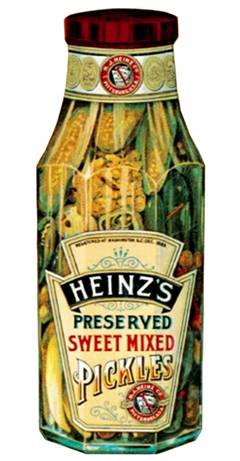Good-bye Barrels, Hello Jars
It was the 1890s. America was nearing the end of one hundred years of remarkable change, change that had taken it out of the world of Thomas Jefferson, and would soon bring it into the world of Teddy Roosevelt. A very tangible part of that change was the way the nation fed itself. Rural families had always cured home-grown produce in ceramic crocks. They used root cellars for winter storage of their durable vegetables (cabbages, potatoes, onions, carrots). Once Mr. Mason invented his jars, things got easier, but the task still had to be done.
By mid-century, however, the rise of industry meant that people increasingly lived in cities. Tenements had no gardens or root cellars. Most blue-collar urban families, many of whom were immigrants, were reluctantly learning to live without preserving their own foods. City folk had to buy, not grow, what they ate, and no matter what they bought, it probably was far different from the foods they preferred.
Consider the phrase "pickle barrel." Even today, it evokes nostalgia for crunchy, tasty dill pickles in old-time country stores. The obvious implication is that dill pickles offered a more memorable taste than anything else the store sold - and sadly, they probably did. Until the waves of Italians, Germans, Slavs, Asians, etc. broke on our shores, much American food was not heavily spiced, and immigrants found it bland.
Around 1860, Pittsburgh teenager John Henry Heinz had pioneered the concept of putting commercially-prepared foods into jars. He began by selling his own prepared horse radish door-to-door. Soon, his business grew large enough to begin supplying his products to merchants. By the 1890s, American stores were stocking their shelves with a great number of his tasty items, items which evoked the delicacies that customers might recall from "the old country." He offered many types of pickled cucumber items, marinated in a choice of spices, as well as pickled cauliflower, pepper, and tomato products. His concoctions gave grateful customers a choice of ways to complement the affordable meats that blue-collar families ate.

Crate-label painting of Heinz "octagon jar" with mixed pickles c.1894
morfauction.com
Eventually, Mr. Heinz hit on the idea of emphasizing the multitude of choices his company offered. He began advertising its "57 Varieties" - 57 being a number he felt would stay in the public's mind (in reality, he was already selling more products than that). The Heinz Company grew steadily, encompassing distant markets and growers almost all over the world.

H.J. Heinz Company advertisement, 1924
archbridgeinstitute.org
***

